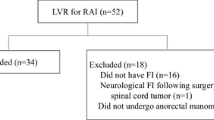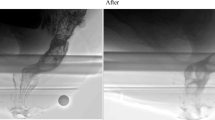Abstract
Background
Rectoanal intussusception (RAI) is a common finding on evacuation proctography in patients with defecation disorders. However, it remains unclear whether intussusception morphology affects the severity of fecal incontinence (FI). The aim of this study was to examine the effect of morphology during defecation on the severity of FI in patients with RAI.
Methods
We included 80 patients with FI who were diagnosed as having RAI on evacuation proctography. Various morphological parameters were measured, and the level of RAI was divided by the extent of descent onto (level I) or into (level II) the anal sphincter. FI symptoms were documented using the FI Severity Index (FISI).
Results
Twenty-eight patients had level I and 52 had level II RAI. The mean (range) FISI score was 24.0 (8–47). FISI scores tended to be significantly higher in level II than in level I [26.3 (10–47) vs. 21.8 (8–42); p = 0.05]. The mean anterior intussusception descent was significantly greater in level II than in level I [24.2 (9.2–39.5) vs. 17.7 (7.8–39.4) mm; p < 0.0001]. Regression analysis showed that anterior intussusception descent was predictive of increased FISI scores.
Conclusions
The severity of FI may be affected by anterior intussusception descent in patients with RAI.

Similar content being viewed by others
References
Mellgren A, Bremmer S, Johansson C et al (1994) Defecography. Results of investigations in 2,816 patients. Dis Colon Rectum 37:1133–1341
Brodén B, Snellman B (1968) Procidentia of the rectum studied with cineradiography. A contribution to the discussion of causative mechanism. Dis Colon Rectum 11:330–347
Wijffels NA, Jones OM, Cunningham C, Bemelman WA, Lindsey I (2013) What are the symptoms of internal rectal prolapse? Colorectal Dis 15:368–373
Shorvon PJ, McHugh S, Diamant NE, Somers S, Stevenson GW (1989) Defecography in normal volunteers: results and implications. Gut 30:1737–1749
Slawik S, Soulsby R, Carter H, Payne H, Dixon AR (2008) Laparoscopic ventral rectopexy, posterior colporrhaphy and vaginal sacrocolpopexy for the treatment of recto-genital prolapse and mechanical outlet obstruction. Colorectal Dis 10:138–143
Collinson R, Wijffels N, Cunningham C, Lindsey I (2010) Laparoscopic ventral rectopexy for internal rectal prolapse: short-term functional results. Colorectal Dis 12:97–104
Pomerri F, Zuliani M, Mazza C, Villarejo F, Scopece A (2001) Defecographic measurements of rectal intussusception and prolapse in patients and in asymptomatic subjects. Am J Roentgenol 176:641–645
Dvorkin LS, Gladman MA, Epstein J, Scott SM, Williams NS, Lunniss PJ (2005) Rectal intussusception in symptomatic patients is different from that in asymptomatic volunteers. Br J Surg 92:866–872
Choi JS, Salum MR, Moreira H, Weiss EG, Nogueras JJ, Wexner SD (2000) Physiologic and clinical assessment of patients with rectoanal intussusception. Tech Coloproctol 4:29–33
Collinson R, Cunningham C, D’Costa H, Lindsey I (2009) Rectal intussusception and unexplained faecal incontinence: findings of a proctographic study. Colorectal Dis 11:77–83
Rockwood TH, Church JM, Fleshman JW et al (1999) Patient and surgeon ranking of the severity of symptoms associated with fecal incontinence: the Fecal Incontinence Severity Index. Dis Colon Rectum 42:1525–1532
Takahashi T, Yamana T, Sahara R, Iwadare J (2006) Enterocele: What is the clinical implication? Dis Colon Rectum 49:S75–S81
Bartram CI, Turnbull GK, Lennard-Jones JE (1988) Evacuation proctography: an investigation of rectal expulsion in 20 subjects without defecatory disturbance. Gastrointest Radiol 13:72–80
Harmston C, Jones OM, Cunningham C, Lindsey I (2011) The relationship between internal rectal prolapse and internal anal sphincter function. Colorectal Dis 13:791–795
Farouk R, Duthie GS, MacGregor AB, Bartolo DC (1994) Rectoanal inhibition and incontinence in patients with rectal prolapse. Br J Surg 81:743–746
Roberts JP, Williams NS (1992) The role and technique of ambulatory anal manometry. Baillieres Clin Gastroenterol 6:163–178
Dietz HP, Zhang X, Skek KL, Guzman RR (2015) How large does a rectocele have to be to cause symptoms? A 3D/4D ultrasound study. Int Urogynecol J 26:1355–1359
Formijne Jonkers HA, Poierrié N, Draaisma WA, Broeders IA, Consten EC (2013) Laparoscopic ventral rectopexy for rectal prolapse and symptomatic rectocele: an analysis of 245 consecutive patients. Colorectal Dis 15:695–699
Portier G, Kirzin S, Cabarrot P, Queralto M, Lazorthes F (2011) The effect of abdominal ventral rectopexy on faecal incontinence and constipation in patients with internal intra-anal rectal intussusception. Colorectal Dis 13:914–917
Tsunoda A, Ohta T, Kiyasu Y, Kusanagi H (2015) Laparoscopic ventral rectopexy for rectoanal intussusception: postoperative evaluation with proctography. Dis Colon Rectum 58:449–456
Jones OM, Cunningham C, Lindsey I (2011) The assessment and management of rectal prolapse, rectal intussusception, rectocoele, and enterocoele in adults. BMJ 342:c7099
González-Argenté FX, Jain A, Nogueras JJ, Davila GW, Weiss EG, Wexner SD (2001) Prevalence and severity of urinary incontinence and pelvic genital prolapse in females with anal incontinence or rectal prolapse. Dis Colon Rectum 44:920–926
Wijffels N, Collinson R, Cunningham C, Lindsey I (2010) What is the natural history of internal rectal prolapse? Colorectal Dis 12:822–830
Lazorthes F, Gamagami R, Cabarrot P, Muhammad S (1998) Is rectal intussusception a cause of idiopathic incontinence? Dis Colon Rectum 41:602–605
Acknowledgments
The authors would like to thank Dr. Yuko Tsunoda for the statistical analyses.
Author information
Authors and Affiliations
Corresponding author
Ethics declarations
Conflict of interest
The authors declare that they have no conflict of interest.
Ethical approval
This study was approved by the Ethical Committee of Kameda Medical Center.
Informed consent
Informed consent was obtained from all individual participants included in the study.
Rights and permissions
About this article
Cite this article
Tsunoda, A., Takahashi, T., Ohta, T. et al. Anterior intussusception descent during defecation is correlated with the severity of fecal incontinence in patients with rectoanal intussusception. Tech Coloproctol 20, 171–176 (2016). https://doi.org/10.1007/s10151-015-1423-1
Received:
Accepted:
Published:
Issue Date:
DOI: https://doi.org/10.1007/s10151-015-1423-1




